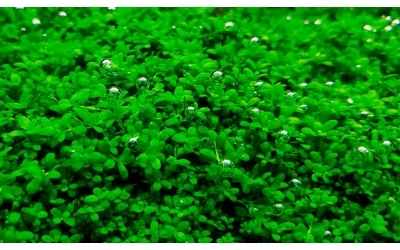Dwarf Baby Tears (Hemianthus callitrichoides) is a very popular aquarium plant among the pet fish keepers due to its greenish coloration and hardiness. It belongs to the family Scrophulariaceae under order Lamiales. It was described in aquaristic literature for the first time in 2003 by Holger WindelÃ.
Systematic Position
Distribution and Habitat
It is native to Cuba and in nature, it is found in submerged condition within up to 1 meter depth ranges of riverbed where strong water current is available.
Common Names
It is also known as Dwarf Baby Tears (DBT), Cuba, Hemianthus Cuba, Pear Grass or simply HC.
Quick Dwarf Baby Tears Facts
Physical Description
Dwarf Baby Tears can grow up to 3 cm long but spreads up to 10 cm horizontally. It has delicate stems with tiny roundish to ovoid leaves. The size of the leaf is 3-4 millimeters that make it the smallest aquarium plant in the world. Generally, it is used as foreground cover.

To make your aquarium more attractive, you should plant it in grouping with other foreground plants such as Eleocharis species. This small plant is especially suitable for nano aquariums. Under favorable condition, Hemianthus Callitrichoides creates oxygen bubbles known as ‘perling’. This ‘perling’ provides a very beautiful feature when the lights are on and shimmering off the bubbles.
This plant is suitable for spawning fish to lay their eggs and shrimp tanks. This plant helps to prevent excess algae growth and improve the water quality in your aquarium. To fill the crevices between rocks and driftwoods and make the tight space in your aquascape, it is an ideal plant.
Also Read: Best Fish Tanks 2018 – Buyer’s Guide & Reviews
Proper Housing and Care Facts
Dwarf Baby Tears is a moderate to slow growing plant. Under captive condition it requires abundant lighting, nutrient rich and fine-grained substrate such as aqua soil and good CO2 supplementation. For proper growth in the aquarium, lighting should be two watts or more per gallon of water. In this case, compact fluorescent lighting is suitable.
This plant produces tiny white flowers under immersed condition but the flowers are extremely small and easy to overlook. It is a beautiful plant and makes thick and lush green carpet that spreads across the foreground.
It is an amazing foreground plant that can form a thick mat and easily spread in the aquarium base. During plantation, you should plant it in little bunches with a couple of centimeters apart. It does well in favorable water quality with a pH of 5.0-7.50, hardness of 4-5 dGH and the temperature of 64-82° F (18-28° C).
To prevent undesirable accumulation of excess nutrients and waste products 20-25% aquarium water should be changed every other week. For sound growth of the plants in aquarium, ideal water circulation is essential. In this case, you can use best aquarium air pumps that are available in pet supplies market with sensible cost.
Propagation / Reproduction
Dwarf Baby Tears or Hemianthus callitrichoides can easily multiply under captive condition if proper care is taken. It does propagate via new shoots or runners. For proper propagation, you should cut off the runners from healthy parents. Before planting, you should drain out the water from the aquarium; planting is done in a moist substrate and after planting is complete, fill the tank very slowly to stop the plant from floating.
During plantation, you should plant it in little bunches with a couple of centimeters apart. In this case, cutting part of runners push into the area where suitable aquarium substrate like aqua soil is available for perfect propagation. Following few days, they form new plants and spread rapidly in the aquarium bottom. It can also do sexual reproduction through seed formation under suitable condition.
Conclusion
Dwarf Baby Tears or Hemianthus callitrichoides is an ideal foreground plant for any aquarium. This type of plant provides suitable space for fish to lay their eggs. This plant becomes popular among the pet fish keepers day by day as a foreground plant due to its greenish coloration and toughness. It is now available in the pet fish market with sensible cost. To make thick and lush green carpet across the foreground areas in the aquarium, we recommend you to purchase these world`s smallest plants for your aquarium. On the other note Cabomba caroliniana would also be a good option.
